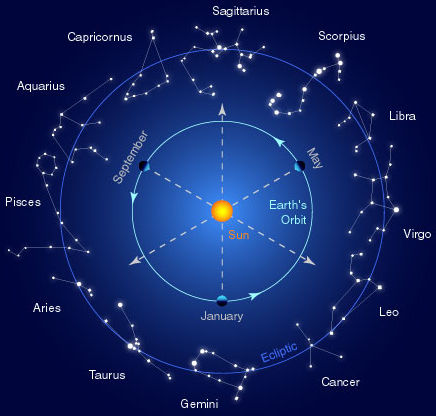The Zodiac
|
As the Earth travels around the Sun, the Sun appears to pass in front of
a succession of constellations.
The linear path that the Sun describes across the sky is called the ecliptic. The constellations
on that path are collectively called the zodiac and extend a few degrees above and
below the ecliptic line.
The ecliptic is a line where the plane described by the Earth's orbit around the Sun crosses the celestial sphere. The plane is close to those described by many other bodies of the solar system. That is why the zodiac is the region of the sky where we find the planets and the asteroid belt, i.e. the disk of our solar system. The zodiac (circle of animals) is the oldest known celestial coordinate system, probably dating back to about 5000 BC in ancient Babylon. It remained the principle method of describing points in the sky until the use of telescopes required a more precise system. Different cultures have different definitions of the characters and borders in the sky. The Babylonian zodiac described 18 constellations instead of 12. The newest member of the modern set is Libra, which the Romans added about 2000 years ago. Libra use to be part of the scorpion; his claws. The arabic names of the two brightest stars in Libra reflect the older description. Zuben el genubi means "the southern claw" and Zuben eschemali means "the northern claw." The constellations of the zodiac, and the dates that the Sun passes through them, do not correspond to the ones listed in astrological horoscopes. The Earth's orientation in space has changed and those descriptions are antiquated; see precession of the equinox. The table above describes the current path of the Sun around the celestial sphere. Notice that although there are 12 "signs of the zodiac," there are actually 13 constellations on the Sun's path. 
|
|
